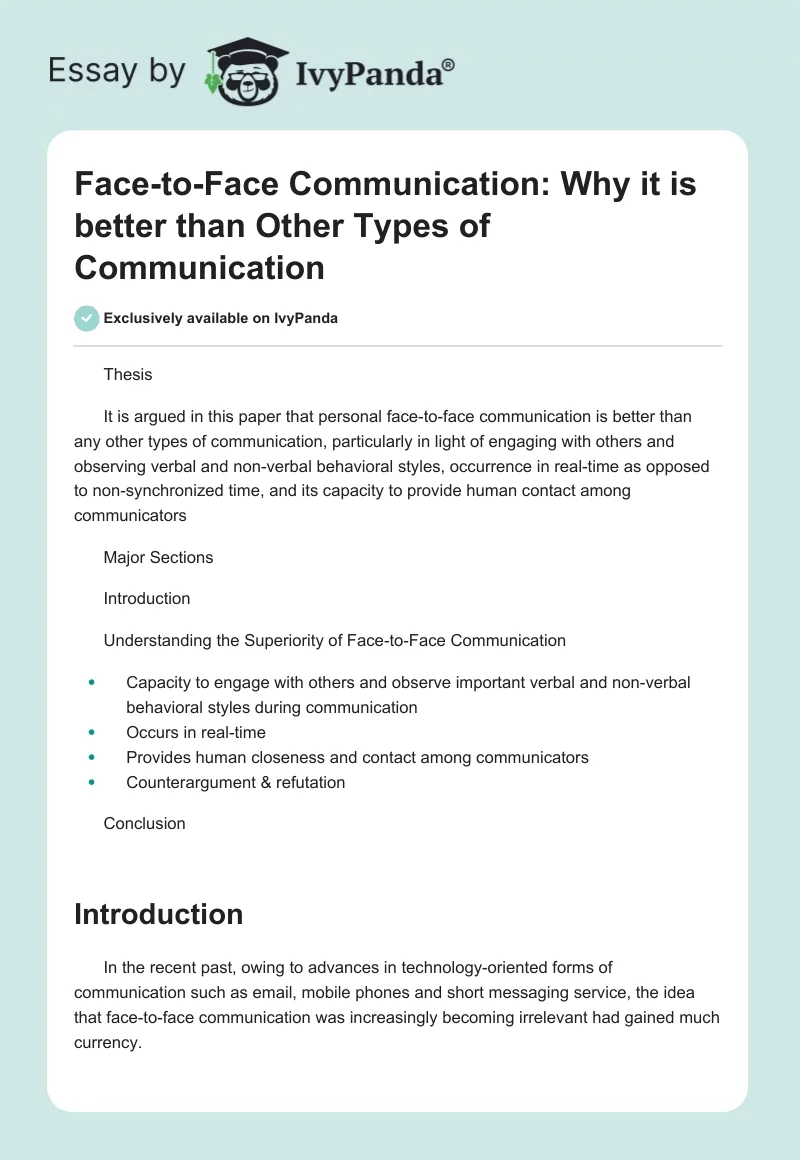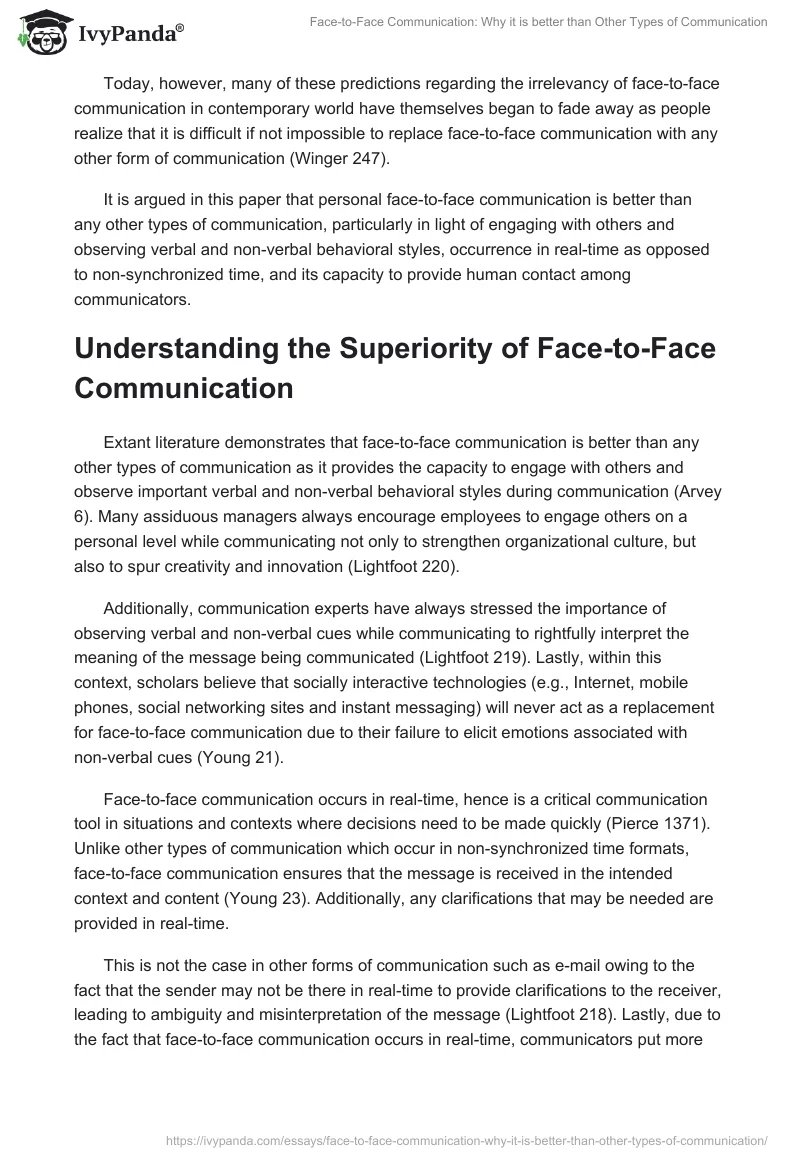Introduction
In the recent past, owing to advances in technology-oriented forms of communication such as email, mobile phones and short messaging service, the idea that face-to-face communication was increasingly becoming irrelevant had gained much currency.
Today, however, many of these predictions regarding the irrelevancy of face-to-face communication in contemporary world have themselves began to fade away as people realize that it is difficult if not impossible to replace face-to-face communication with any other form of communication (Winger 247).
It is argued in this paper that personal face-to-face communication is better than any other types of communication, particularly in light of engaging with others and observing verbal and non-verbal behavioral styles, occurrence in real-time as opposed to non-synchronized time, and its capacity to provide human contact among communicators.
Understanding the Superiority of Face-to-Face Communication
Extant literature demonstrates that face-to-face communication is better than any other types of communication as it provides the capacity to engage with others and observe important verbal and non-verbal behavioral styles during communication (Arvey 6). Many assiduous managers always encourage employees to engage others on a personal level while communicating not only to strengthen organizational culture, but also to spur creativity and innovation (Lightfoot 220).
Additionally, communication experts have always stressed the importance of observing verbal and non-verbal cues while communicating to rightfully interpret the meaning of the message being communicated (Lightfoot 219). Lastly, within this context, scholars believe that socially interactive technologies (e.g., Internet, mobile phones, social networking sites and instant messaging) will never act as a replacement for face-to-face communication due to their failure to elicit emotions associated with non-verbal cues (Young 21).
Face-to-face communication occurs in real-time, hence is a critical communication tool in situations and contexts where decisions need to be made quickly (Pierce 1371). Unlike other types of communication which occur in non-synchronized time formats, face-to-face communication ensures that the message is received in the intended context and content (Young 23). Additionally, any clarifications that may be needed are provided in real-time.
This is not the case in other forms of communication such as e-mail owing to the fact that the sender may not be there in real-time to provide clarifications to the receiver, leading to ambiguity and misinterpretation of the message (Lightfoot 218). Lastly, due to the fact that face-to-face communication occurs in real-time, communicators put more thought in what they say than they would when communicating using other modes such as email or mobile phones (Lightfoot 223).
The third reason deals with the provision of human closeness and contact among communicators. Available literature demonstrates that “being physically close brings into play in a robust way all of the senses: sight, sound, smell and touch” (Winger 248).
Moreover, personal face-to-face communication enables humans to achieve the primitive need of contact in line with scientific findings that people are social creatures that should not be allowed to live in isolation (Arvey 6). Lastly, research demonstrates that the human contact occasioned by face-to-face communication provides an enabling environment for people to develop substantial exchange relationships among themselves (Young 25).
Of course critics often argue that it is just a matter of time before socially interactive technologies replace face-to-face communication as the dominant mode of communication. Indeed, extant literature demonstrates that “in 2005, more than 21 million adolescents between the ages of 12 and 17 had access to and routinely used the internet” (Pierce 1367). But in view of the many values of face-to-face communication as discussed above, it is difficult to foresee a scenario where this form of communication will ever become irrelevant.
Conclusion
In conclusion, it is evident that face-to-face communication will rule the world scene for years due to the stated strengths of engaging with others, employment of verbal and non-verbal behavioral cues, occurrence in real-time, and provision of human contact and closeness among communicators. No any other form of communication can be as clearer and understandable as face-to-face communication.
Works Cited
Arvey, Richard D. Why Face-to-Face Business Meetings Matter. n.d. Web.
Lightfoot, Jay M. “A Comparative Analysis of E-mail and Face-to-Face Communication in an Educational Environment.” Internet and Higher Education. 9.2 (2006): 217-227. Web.
Pierce, Tamyra. “Social Anxiety and Technology: Face-to-Face Communication versus Technological Communication among Teens.” Computers in Human Behavior. 25.6 (2009): 1367-1372. Academic Search Premier. Web.
Winger, Alan R. “Face-to-Face Communication: Is it Really Necessary in a Digitalized World?” Business Horizons. 48.2 (2005): 247-253. Web.
Young, David P. “The Relationship between Electronic and Face-to-Face Communication and its Implication for Alternative Workforce Strategies.” Facilities. 13.6 (1995): 20-27. Emerald. Web.


